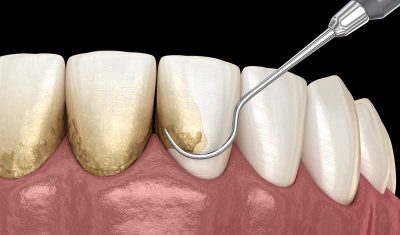
Gum disease is an infection in the gums that can destroy the bone surrounding and supporting your teeth. Also known as periodontal disease or periodontitis, it starts with bacterial growth in your mouth. When left untreated, it can lead to tooth loss and increase your risk of suffering a stroke or heart attack. It is the leading cause of tooth loss in adults.
Symptoms
Most of the time gum disease progresses slowly, so many people are not aware they have it until in the later stages. Symptoms include:
- Red, swollen and tender gums
- Gums that bleed during and after brushing and/or flossing
- Persistent bad breath or bad taste in the mouth
- Receding gums
- Teeth that feel loose
- Developing deep pockets between teeth and gums
- Changes to your bite
Causes
Poor oral hygiene is the main cause gum disease. When you don’t brush or floss regularly, plaque builds up around your teeth and gums. Bacteria in plaque produce acids that attack your tooth enamel and cause tooth decay. Plaque hardens into tartar that forms along the gum line and makes it hard to clean your teeth and gums properly, allowing the plaque to thrive. Over time the bacterial toxins attack the bone and ligaments surrounding your teeth.
Hormonal changes can contribute to gum disease, particularly during pregnancy, puberty or menopause. At these times your gums can be more sensitive than normal, which makes them more vulnerable.
Some illnesses and health conditions can make you more prone to gum infections, including cancer, HIV and diabetes which all interfere with your immune system. There are also some medications which affect your teeth, gums and lessen the flow of saliva to lead to increased risk.
Gum Disease Treatment
Regular dental check ups and dental hygiene appointments are essential in both preventing and treating gum disease. Early detection is key! The most effective gum disease treatment is a combination of having good brushing and flossing habits at home, as well as seeing your dentist and dental hygienist regularly. Professional teeth cleaning at least twice per year (or as recommended by your Dentist) removes plaque and tartar build up from above and below the gum line. These appointments, and having good at-home cleaning routines, can effectively prevent, halt and in some cases even reverse the disease.
If gum disease has progressed beyond the early stages, a nonsurgical treatment called scaling and root planing can be performed under local anaesthetic. It involves scraping away plaque and tartar both above and below the gum line and planing rough spots on the tooth root.
In later stages, gum disease treatment can require oral surgery. Flap surgery, also known as pocket reduction surgery, involves lifting the gums back so tartar can be removed and then the gums are replaced snugly around the tooth to reduce the pockets and provide better protection. Bone grafts can be surgically performed to replace bone destroyed by gum disease, and soft tissue grafts can be done to reinforce or fill in receding gums.
Please contact us if you have any concerns regarding gum disease. We can conduct an assessment and recommend treatment options for your needs.